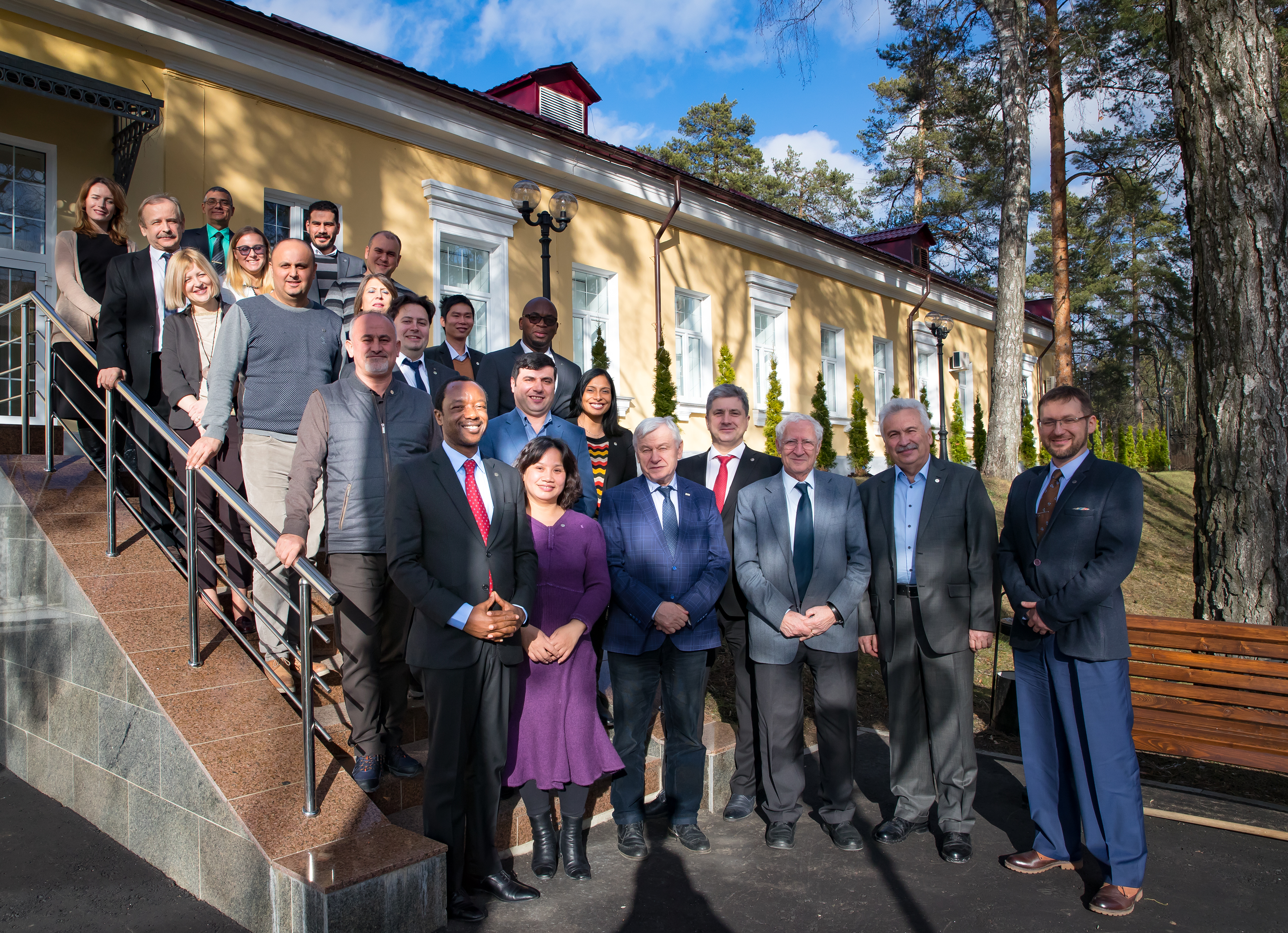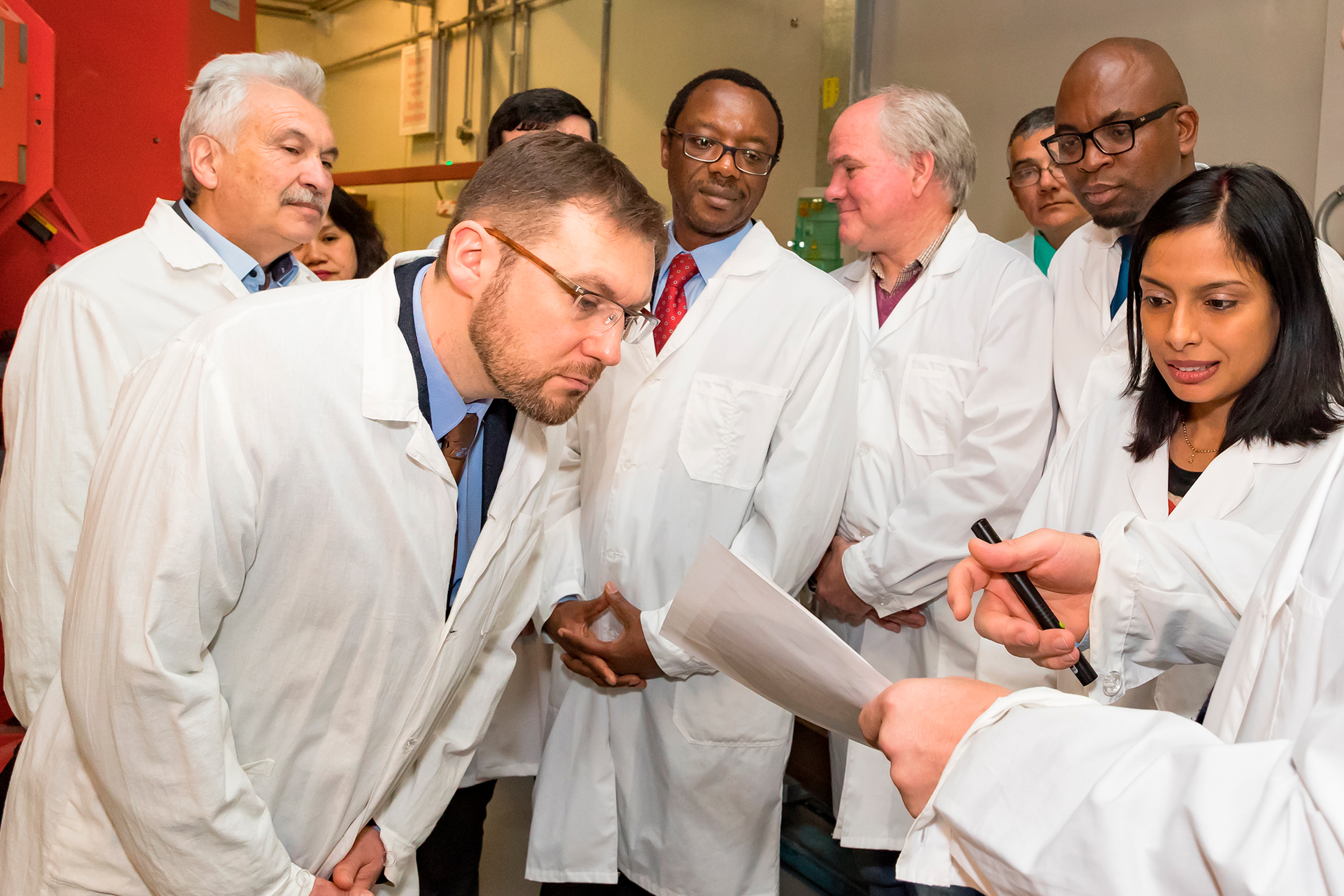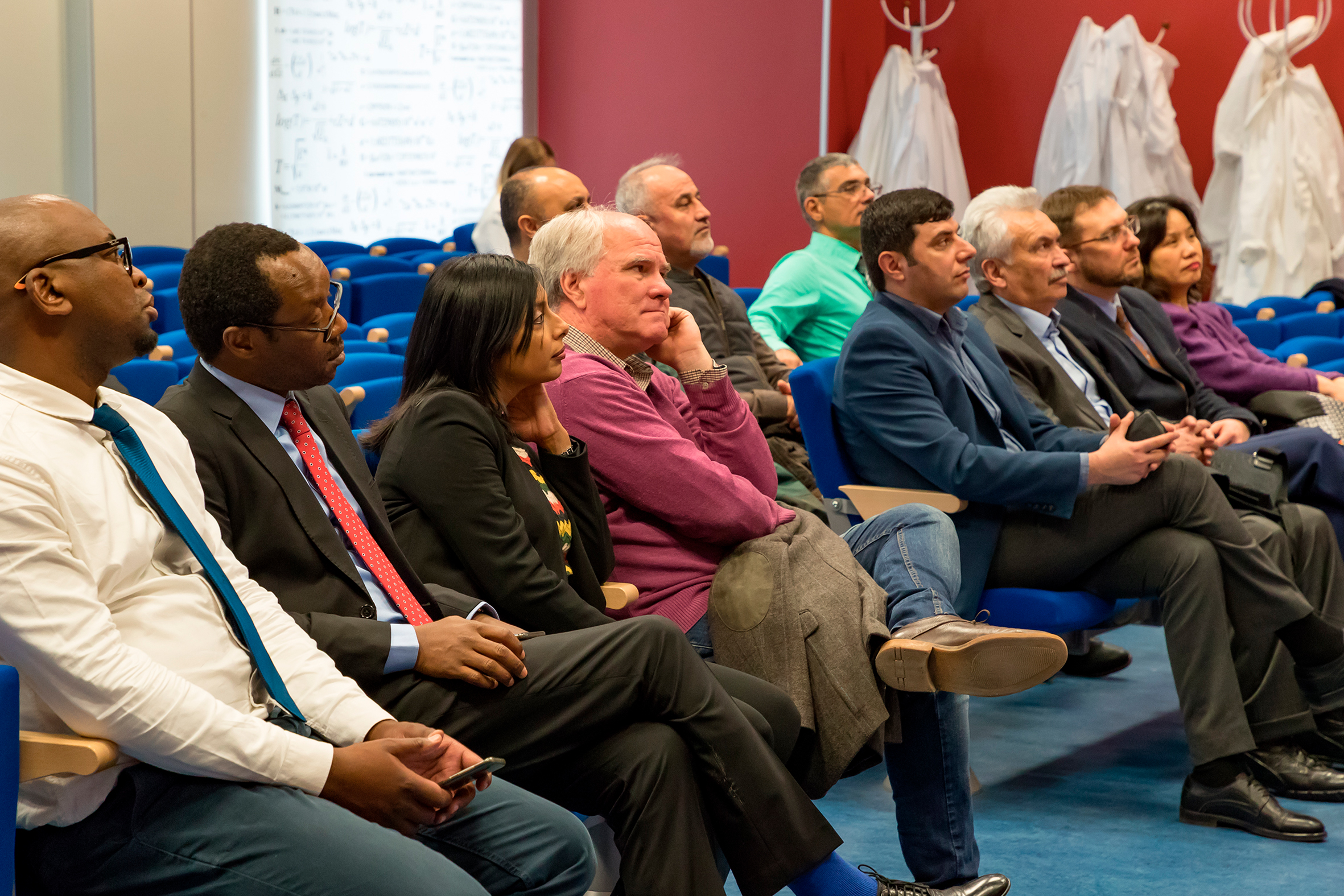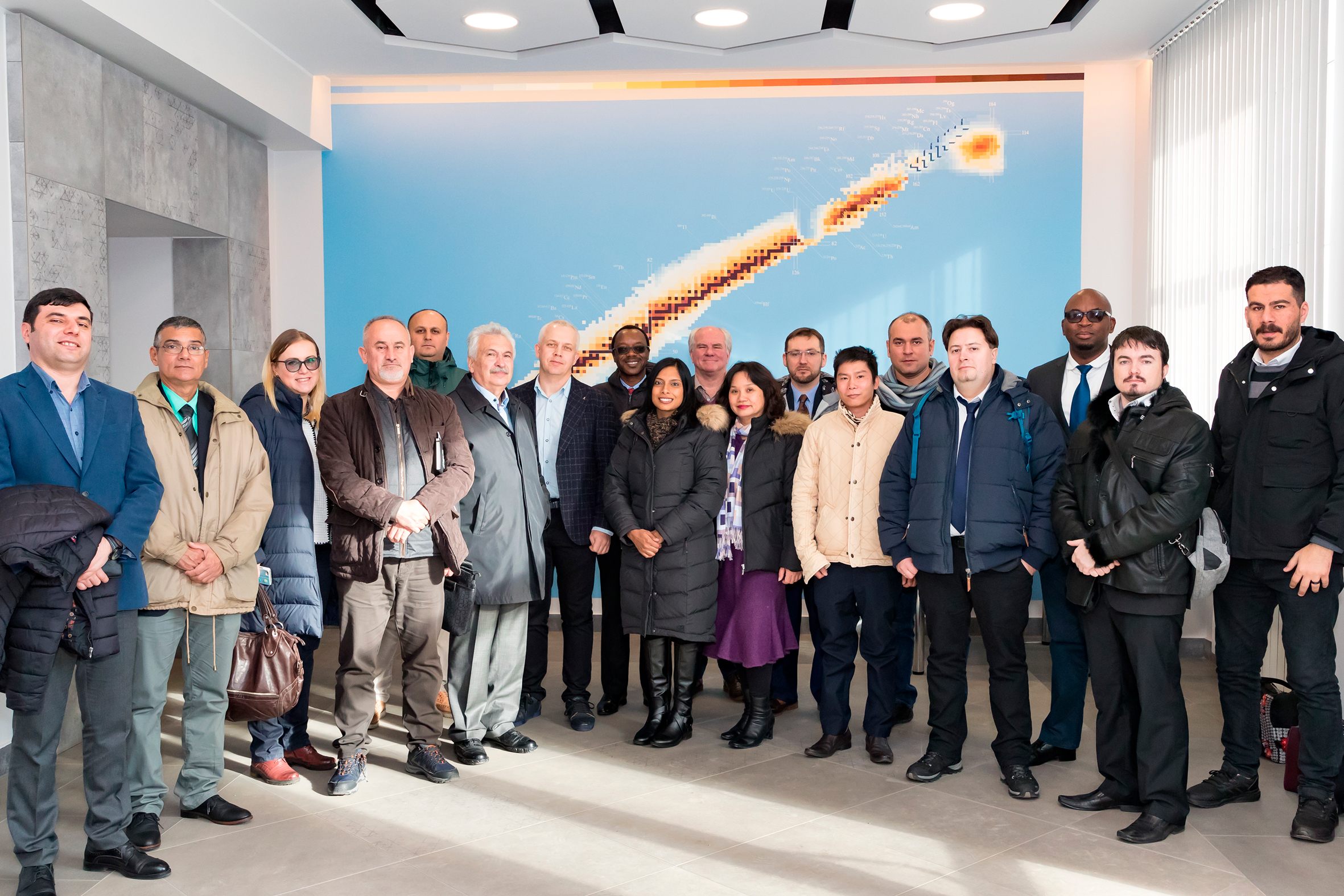15th JEMS training programme ended: new time format, new countries, new projects
News, 01 March 2020
On 28 February 2020, the results of the 15th International training programme for decision-makers in science and international scientific cooperation “JINR Experience for Member States and Partner Countries” (JEMS-15) were summed up at the traditional round table. On behalf of the JINR Directorate, Vice-Directors Mikhail Itkis and Richard Lednický took part in the round table and festively presented certificates of internship to the participants at the end of the meeting.
JEMS-15 organizers successfully coped with the task of delivering a rich training programme in a four-day format, instead of the usual five days. The participants got a detailed overview of the Institute’s activities after listening to thematic lectures by leading experts and visiting JINR laboratories and its scientific infrastructure.
Many of the speakers at the round table emphasised the need to spread information about JINR research directions and opportunities for cooperation in their countries. In this regard, the idea of JINR information centres, the first of which was opened in Vladikavkaz, was actively developed at JEMS-15: such information centres were planned to be opened in Cairo and Kamchatka. Speaking about their impressions, participants repeatedly expressed a wish to have more time for working contacts with their internship colleagues in order to take full advantage of JEMS as a platform for organizing joint projects. The shortage of time did not affect the productivity of the training. Thus, one of the practical outcomes was the signing of a cooperation agreement between JINR and the University of Pretoria. At the meeting, participants talked about arrangements for cooperation with JINR laboratories, and new ideas for joint projects were heard right at the round table.
For the first time, representatives from Armenia took part in the JEMS training programme. Gevorg Karyan, Deputy Director of the A.I. Alikhanyan National Science Laboratory of the Yerevan Physics Institute (YerPhI), “These days we have enjoyed the special atmosphere of your Institute. We will take its spirit with us to share it with our colleagues, especially the young specialists. I am sure that this will stimulate interest in visiting JINR to carry out research work. I hope to develop our cooperation with JINR and on behalf of our Institute I thank you for this internship”. Vachagan Harutyunyan, Head of Applied Physics Research Division, YerPhI National Science Laboratory, continued his colleague’s speech, “During these days we have paved the path, now it has to be expanded and enlarged, as we really want it to be. Tomorrow we leave for Yerevan and bring to our Heads the prepared protocol on cooperation with the Laboratory of Neutron Physics. This document will give us energy and enable us to include new young scientists in our collaboration with JINR in various fields. During these four days we have learnt so much, it would take more than a lifetime to cover all the research going on here.”
Another new geographical location for JEMS training is Turkey. Serdan Bulut, Head of the Proton Accelerator Project, Turkish Atomic Energy Authority (TAEK), “During this training, we received a great deal of information about JINR and its scientific infrastructure. I think that Turkey will increase its cooperation with JINR in the near future. I believe that there is a need to raise awareness of the Joint Institute’s capabilities in Turkey. Many of our scientists are eager to establish cooperation with CERN, simply because they do not know what JINR has to offer them. A second Turkish delegate confirmed his colleague’s words. İsmail Hakkı Sarpun, Director of the Centre for Nuclear Physics Research and Applications, Akdeniz University, who said that he is very interested in FLNR JINR research on exotic nuclei and has already planned to take part in the 10th International Symposium on Exotic Nuclei (EXON-2020) in St. Petersburg in July this year with the aim of developing cooperation in this direction.
Bulgaria, Cuba, Egypt, Russia, South Africa and Vietnam have already sent representatives to JEMS many times.
Petar Vankov, Head of the Qualification and Verification Department of the Bulgarian Nuclear Regulatory Agency (BNRA), spoke about his impressions, “The internship was of great personal interest to me in the light of my recent appointment at BNRA as a member of the consultation committee of our plenipotentiary representative for cooperation with Dubna. I was well aware of JINR research in high-energy physics, and now know the full range of the Institute’s research. For example, I became acquainted with the very interesting directions of radiation biology and proton therapy. I am sure that we will use the information received for further development of JINR-Bulgaria cooperation. As a piece of advice, I would point out that the internship programme was very intense. It would have been useful to have more free time to establish working contacts with the other participants”.
Ignacio Hernandez Gonsales, Head of Isotope Centre Development Department (CENTIS, Cuba), “It was a wonderful opportunity to learn about the large number of research directions in which Cuba could participate in the future. I am very pleased to have the opportunity to act as a JINR ambassador in my country. Not only specific joint projects are important, the most valuable thing is the new ideas I gained here, which I will bring to my country. It is possible that I will come back here as an employee of the Laboratory of Radiation Biology JINR.
Alaa Yса́маh Ali, Director of Information Technology, Academy of Scientific Research and Technology of Egypt (ASRT), and Coordinator of the future JINR Information Centre, “It was a great opportunity to get to know JINR in depth. We look forward to further developing our interaction through the work of the ARE-JINR Cooperation Committee in particular. A special tribute to Wael Badawy, thanks to whom we had many productive meetings with JINR technical experts, clarified much for us, and now it will be much easier to resolve related administrative issues. On our return, we have a meeting planned with the President of our Academy. I am sure that this will contribute to strengthening cooperation between JINR and Egypt. Rami Abdel Latif Mohamed, Chief Engineer at ASRT, also spoke about developing cooperation with the Joint Institute, “The main objective of our involvement in JEMS was to work on the JINR Information Centre at our Academy as well as our participation in the JINR Virtual Laboratory project. On our return, we are meeting with our Heads to work out the next steps for the implementation of these tasks and opening of the Information Centre as soon as possible.
This is the second time Evgeny Makarov, a researcher from Vitus Bering Kamchatka State University (KSU) and coordinator of KSU-JINR cooperation, visited the Joint Institute, “I am very glad to be at the Joint Institute again. The plans for joint research emerged on my last visit. This visit was even more interesting and useful for me, I learned a lot. Now we have extensive new plans for cooperation. We consider opening of the JINR Information Centre to inform teachers, pupils, and students in Kamchatka about the capabilities of the Joint Institute and to use the JINR Virtual Laboratories.”
Tawana Kupe, Principal of the University of Pretoria spoke about South Africa’s participation in the 15th JEMS internship and their impressions, “During this training, we gained information that one wouldn’t get on one’s own research. We saw the widest range of scientific facilities, including those that could be considered historic, and this gave us the opportunity to trace the development of scientific technology. For humanity to thrive in the challenging conditions of today’s world, a global pooling of efforts and knowledge is needed. It is a mission that international scientific centres like JINR can fulfil. High scientific results are not possible without the appropriate scientific infrastructure. JINR stands here as an excellent example of what can be achieved, backed up by a high quality infrastructure and investment in science. This tandem gives birth to bright new ideas, no wonder a Nobel laureate appeared here. The Joint Institute is a place where countries work together to create world-class science. For this reason, we signed a memorandum of cooperation during JEMS-15 and were the first South African university to sign such an agreement with JINR. My only regret is that there was not enough time to talk to each of the participants of the training, and maybe even to hold a joint meeting, as JINR is an excellent platform for building international cooperation.”
Representatives from Vietnam regularly come to JEMS and this time two new Vietnamese universities were represented in the ranks of the participants of the internship. Duy Tan University (DTU) was represented by Chief Researcher Toan Dang Ngo who also acted as a contact person for DTU and JINR cooperation, “I had an assignment from my supervisor Professor Kim to establish working contacts between colleagues from DTU and JINR. Thanks to information about the JINR University Centre, I saw ways to organize this cooperation and excellent opportunities for long-term business trips of young talented Vietnamese scientists to JINR. Another very interesting direction for us, which I learned about after a visit to the Laboratory of Neutron Physics, was neutron activation analysis. This visit was very impressive and extremely exciting for me.” Mai Huong, Vice-Director of the VINATOM Institute for Technology of Radioactive Waste and Rare Elements, supported her colleague’s idea, “This was my third visit to Dubna, and this time I was able to get the most holistic view of JINR’s research. This allowed me to form a proposal to combine scientific work and training of our young scientists at JINR. We have several major national tasks in front of us that our students could work on here. They are the direction of ecology and radiation safety. In the near future, I plan to participate actively in the development of cooperation between the LRB and the Russian-Vietnamese Tropical Research and Technology Centre to develop radiation protection products. This is a promising opportunity for our postgraduate students to participate. I also see the potential for joint research with the Laboratory of Neutron Physics as part of our State Environment Programme.”
A landmark outcome of the round table was the idea voiced at the end of the meeting by Vachagan Harutyunyan to organize a joint project in cooperation with Vietnam via JINR in the field of application of new radiation research methods for radioactive liquid waste, in which the National Science Laboratory YerPhI had a recognised expertise.






